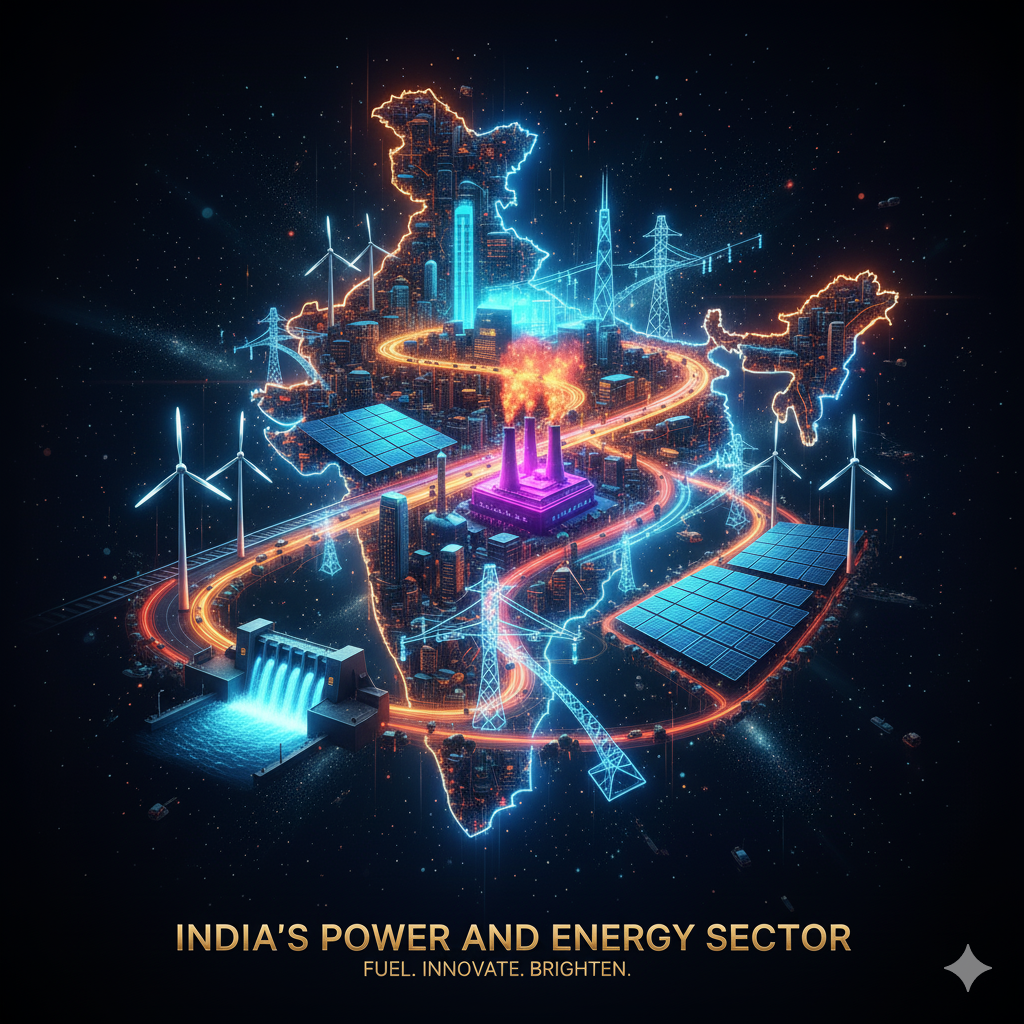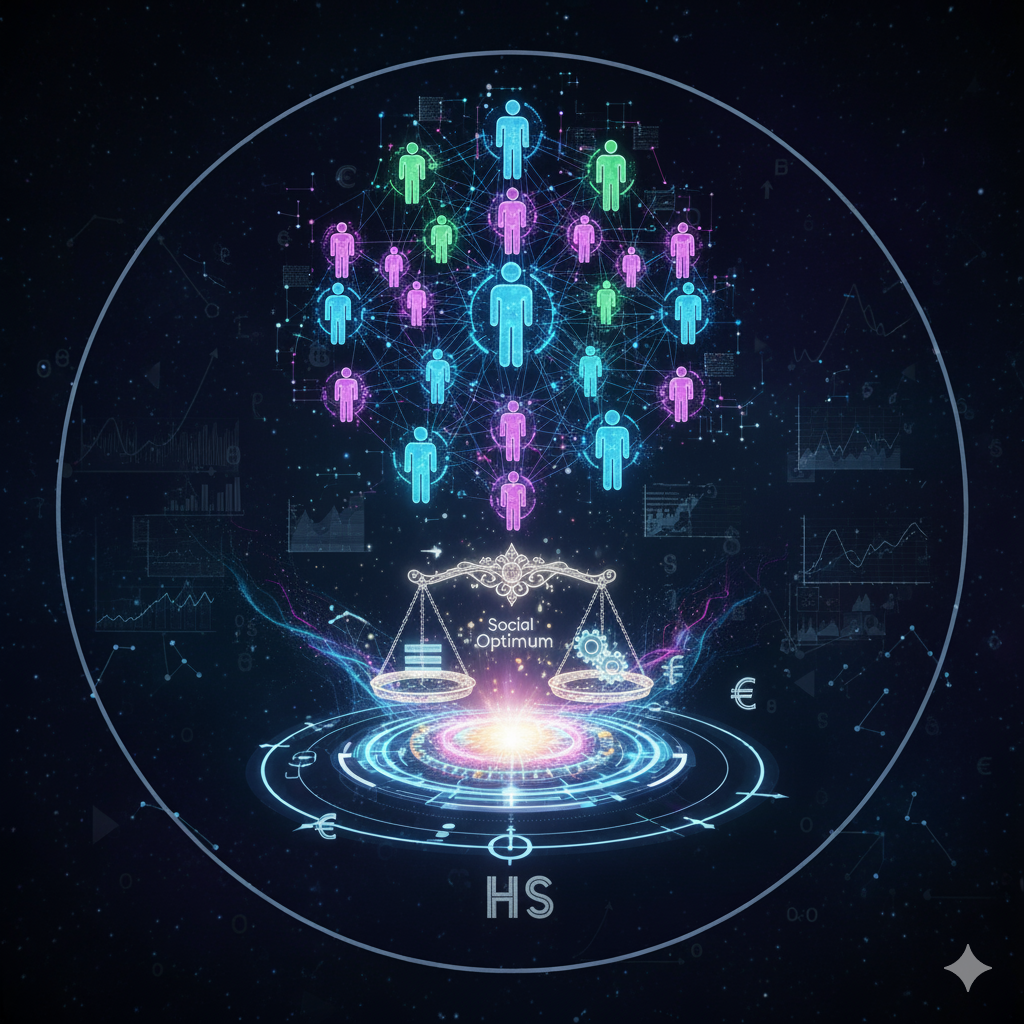Introduction
Energy is the foundation of modern civilization and the key driver of economic development. From industrial production to agriculture, from transportation to communication, and from domestic use to national security — energy plays a critical role in every aspect of life. In India, energy is not only an essential infrastructure component but also a strategic sector that determines the pace of socio-economic growth.
India’s power sector has evolved significantly over the decades, transitioning from energy shortages and inefficiencies to ambitious plans for renewable integration, sustainability, and universal electricity access. The government has set a vision of achieving “Power for All” and making India a global leader in clean and green energy.
Definition of Power and Energy
Energy refers to the capacity to do work. It can exist in various forms — thermal, electrical, chemical, mechanical, solar, and nuclear.
Power is the rate at which energy is produced, transmitted, or consumed. In India, the power sector primarily deals with the generation, transmission, and distribution of electricity derived from multiple energy sources such as coal, hydro, gas, nuclear, solar, and wind.
Historical Development of the Power Sector in India
- Pre-Independence Period:
During the colonial era, power generation was localized, serving limited industrial and urban needs. The first electric supply company was established in Kolkata in 1897. - Post-Independence Period:
The government recognized electricity as a key input for development. Major initiatives were taken through the Five-Year Plans to establish State Electricity Boards (SEBs), hydroelectric projects, and thermal power stations. - Reforms Era (1990s onwards):
The introduction of liberalization and privatization policies opened the sector to private participation. Reforms such as the Electricity Act, 2003, the establishment of the Central Electricity Regulatory Commission (CERC), and initiatives like UDAY (Ujwal DISCOM Assurance Yojana) transformed the sector.
Structure of the Power Sector
The Indian power sector comprises three main segments:
- Generation: Production of electricity using various energy sources.
- Transmission: Transfer of bulk power from generating units to substations.
- Distribution: Delivery of power from substations to end consumers.
Each segment involves both public and private entities, with regulation and coordination provided by central and state-level agencies.
Sources of Energy in India
India’s energy mix is diversified and includes both conventional and non-conventional sources.
1. Thermal Power
- Dominant source, accounting for around 55–60% of total installed capacity.
- Uses coal, gas, or oil as fuel.
- Major plants: Singrauli, Korba, Vindhyachal, and Talcher.
- Challenges include carbon emissions, fuel shortages, and old infrastructure.
2. Hydro Power
- Renewable and clean source.
- India has vast hydropower potential (estimated at 145 GW).
- Key plants: Bhakra Nangal, Tehri, Nathpa Jhakri.
- However, environmental and displacement issues limit expansion.
3. Nuclear Power
- Managed by the Nuclear Power Corporation of India Limited (NPCIL).
- Provides base-load power and enhances energy security.
- Major stations: Tarapur, Kakrapar, Kudankulam.
- Future expansion depends on international collaboration and technology transfer.
4. Renewable Energy (Solar, Wind, Biomass, Small Hydro)
- India aims to achieve 500 GW of non-fossil fuel capacity by 2030.
- Major initiatives: National Solar Mission, Wind Energy Mission, Bioenergy Program.
- Leading renewable states: Rajasthan, Gujarat, Tamil Nadu, Karnataka, Maharashtra.
Goals and Objectives of the Power Sector
- Universal Access to Electricity: Ensure reliable and affordable power to every household and industry.
- Energy Security: Reduce dependence on imported fossil fuels.
- Sustainability: Promote renewable and clean energy.
- Efficiency: Enhance generation, transmission, and distribution efficiency.
- Affordability: Maintain reasonable tariffs for consumers.
- Private Participation: Encourage investment and competition in the power sector.
- Technological Upgradation: Implement smart grids, smart meters, and digital monitoring systems.
Major Policies and Schemes in the Power Sector
1. Deen Dayal Upadhyaya Gram Jyoti Yojana (DDUGJY)
- Focus: Rural electrification.
- Components include feeder separation, rural infrastructure strengthening, and last-mile connectivity.
2. Integrated Power Development Scheme (IPDS)
- Focus: Strengthening sub-transmission and distribution networks in urban areas.
3. Ujwal DISCOM Assurance Yojana (UDAY)
- Objective: Improve financial health and efficiency of distribution companies (DISCOMs).
4. Saubhagya Scheme (Pradhan Mantri Sahaj Bijli Har Ghar Yojana)
- Launched in 2017 to achieve universal household electrification.
- Achieved near 100% electrification by 2019.
5. National Solar Mission
- Target: 280 GW of solar capacity by 2030.
- Promotes solar parks, rooftop solar, and rural solar applications.
6. Green Energy Corridor Project
- Focus on strengthening transmission infrastructure to evacuate renewable energy efficiently.
7. Perform, Achieve and Trade (PAT) Scheme
- Market-based mechanism to enhance energy efficiency in industries.
Approach to Energy Development
- Integrated Energy Planning:
Coordination among ministries, sectors, and states for optimal energy resource utilization. - Public-Private Partnership (PPP):
Encouraging private investments in generation, transmission, and renewable sectors. - Technological Innovations:
Promotion of smart grids, battery storage, and hydrogen energy. - Regulatory Reforms:
Strengthening the Electricity Act and creating transparent tariff systems. - Decentralized Energy Systems:
Encouraging microgrids and distributed generation in remote areas. - International Cooperation:
Collaborating with global institutions and countries for knowledge, technology, and investment (e.g., International Solar Alliance).
Economic and Social Dimensions
Economic Dimension
- The power sector contributes significantly to GDP growth and industrial competitiveness.
- Acts as an enabler for other sectors like agriculture, manufacturing, and services.
- Reduces production costs and enhances exports.
Social Dimension
- Electricity improves living standards, healthcare, education, and communication.
- Rural electrification leads to inclusive growth.
- Women empowerment and education are positively influenced by energy access.
Environmental Dimension
- Shift from fossil fuels to renewables reduces carbon emissions.
- Promotes green and sustainable growth.
- Encourages energy efficiency and conservation.
Funding and Investment Mechanisms
- Budgetary Support: Central and state governments allocate funds through Five-Year Plans and annual budgets.
- Public Sector Undertakings (PSUs): NTPC, NHPC, PGCIL, etc. invest in generation and transmission.
- Private Investment: Encouraged through FDI and PPP models.
- Multilateral Agencies: World Bank, Asian Development Bank (ADB), and JICA support infrastructure projects.
- Green Bonds: Issued to finance renewable and clean energy projects.
- Infrastructure Debt Funds (IDFs): Channel long-term investments for infrastructure including power projects.
Challenges in the Power Sector
- Distribution Losses: High technical and commercial losses due to poor infrastructure.
- Financial Crisis in DISCOMs: Due to subsidies, inefficiencies, and non-recovery of dues.
- Fuel Supply Constraints: Coal shortages and high import dependency.
- Transmission Bottlenecks: Inadequate inter-regional connectivity.
- Environmental Concerns: Pollution and ecological impacts of thermal projects.
- Policy Delays: Complex regulations and approval processes.
- Technology Gap: Limited storage and grid management technologies.
Future Prospects and Vision
India’s energy vision aims at achieving reliable, affordable, and sustainable power.
The government’s National Electricity Plan (NEP) and Vision 2047 outline a roadmap for the next decades.
Key Future Goals:
- Net Zero Emission Target by 2070:
Transition to a low-carbon economy through clean energy expansion. - Renewable Energy Expansion:
Achieve 500 GW of non-fossil fuel capacity by 2030. - Green Hydrogen Mission:
Promote hydrogen as a clean fuel for industries and transport. - Digital and Smart Power Grids:
Integration of artificial intelligence, IoT, and data analytics in grid management. - Energy Storage Systems:
Development of battery storage and pumped hydro facilities. - Regional Energy Cooperation:
Strengthen cross-border energy trade with South Asian nations. - Atmanirbhar Bharat in Energy:
Enhance domestic production of solar panels, batteries, and electric vehicle components.
Sustainable Energy and SDGs
The power sector directly contributes to Sustainable Development Goal (SDG) 7 – Affordable and Clean Energy, and indirectly supports other goals like:
- SDG 9: Industry, Innovation, and Infrastructure
- SDG 11: Sustainable Cities and Communities
- SDG 13: Climate Action
Through renewable expansion and energy access, India aims to ensure inclusive and sustainable development.
Conclusion
India’s power and energy sector stands at the crossroads of growth and sustainability. The journey from power scarcity to energy surplus reflects the nation’s resilience and policy foresight. With technological advancement, global cooperation, and policy innovation, India is moving toward a future of clean, reliable, and equitable energy.
The transformation of the power sector is not just about electricity—it is about empowering every citizen, driving industrial progress, and building a sustainable tomorrow.




